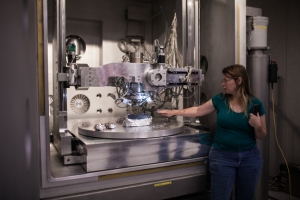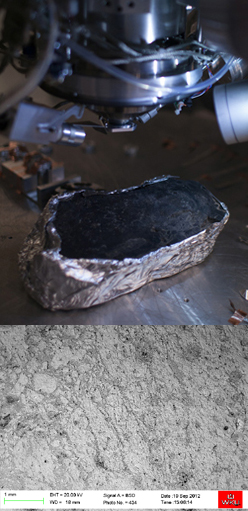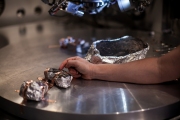Agriculture News
Researcher uses NOVA Center’s LC-SEM to examine Jurassic era fossils
- Thursday, September 20th, 2012
A researcher from Northern Kentucky University is taking advantage of the 21stcentury technology available at WKU’s NOVA Center to examine dinosaur bones and other fossils that are 160 million years old.

Dr. Janet Bertog, associate professor of Paleontology and Stratigraphy at Northern Kentucky University, brought nine Jurassic era fossils to WKU’s NOVA Center for examination in the Large Chamber-Scanning Electron Microscope. (WKU photo by Bryan Lemon)
Dr. Janet Bertog, associate professor of Paleontology & Stratigraphy at NKU, brought nine samples Tuesday for examination at the NOVA Center’s Large Chamber Scanning Electron Microscope (LC-SEM).
The fossils, all found in the Morrison Formation in central Utah, included a section of a femur of a sauropod dinosaur; the jaw of a small mammal; a tooth from an allosaurus; and samples that may be a new species of iguana.
The LC-SEM – the only one of its kind at a North American university — performs scientific, microscopic analysis of large samples, allowing for investigation of large manufactured objects or historical artifacts without destroying them.
“We don’t want to do anything that would damage the fossils,” Dr. Bertog said, noting that the rare and fragile samples are part of several undergraduate research projects under way at NKU.
Creating new research collaborations and providing analytical and technical services are among the goals for the NOVA (Nondestructive Analysis) Center, said Dr. Ed Kintzel, center director and assistant professor in WKU’s Department of Physics and Astronomy.

Top photo: A section of the femur of a sauropod dinosaur was among the fossils examined at WKU’s NOVA Center. Bottom photo: An image of the scan from the Large Chamber-Scanning Electron Microscope. The samples were wrapped in foil to limit the exposed surface and help as a guide to locate regions for study.
“This is our goal – to help someone do something they can’t do somewhere else,” Dr. Kintzel said.
Dr. Bertog learned about the NOVA Center and the LC-SEM from one of her former professors, Dr. Cathleen Webb. Dr. Webb, head of WKU’s Department of Chemistry, was at South Dakota School of Mines and Technology while Dr. Bertog was completing her master’s degree there.
“This is the only place in the country with one,” Dr. Bertog said of the LC-SEM.
Data from the LC-SEM will allow Dr. Bertog to examine growth rings in the femur that may help determine how seasonal and climate variations affected the course of the sauropod’s life. That data will be compared to chemical analysis of the sample that shows the animal may have died from drought conditions. “This is the last little piece we need,” she said.
Growth rings in the bone are similar to growth rings in a tree, Dr. Bertog said. If the animal was stressed, the rings will be smaller, but if the animal was eating well, the rings will be larger.
“We are looking for evidence that it was stressed,” she said.
Dr. Bertog is examining another sample of the sauropod’s toenail for evidence that termites or beetles fed on the bone after the animal died. And by using the LC-SEM to examine the scratch marks on the allosaurus tooth, she may be able to determine whether what it was eating was alive or dead.

Dr. Janet Bertog pointed to a sample of the sauropod’s toenail that she is examining for evidence that termites or beetles fed on the bone after the animal died. (WKU photo by Bryan Lemon)
By analyzing these samples and various other materials from the Morrison Formation site, such as turtles, crocodiles and fish, Dr. Bertog and her students may be able to determine what the environment was like and whether a lake existed there during the Jurassic era.
Dr. Bertog expects to make additional trips to the NOVA Center and bring more samples, including the skull of a barosaurus.
About the NOVA Center: The NOVA (Nondestructive Analysis) Center, located at WKU’s Center for Research and Development on the corner of Nashville Road and Campbell Lane, features the Large Chamber Scanning Electron Microscope (LC-SEM). The acquisition of the LC-SEM has positioned WKU as the only university in North America with an instrument of this type and as a leader in nondestructive analysis testing. The only other similar equipment is at Tinker Air Force Base in Oklahoma. The LC-SEM performs scientific, microscopic analysis of extremely large samples, allowing for investigation of components without destroying them. Maximum sample size is 40 inches diameter by 40 inches tall, with a weight limit of 650 pounds. This allows it to easily hold a V-6 engine block. The LC-SEM has a magnification power of 100,000 times, which is 100 times that of a standard light microscope.
Contact: Ed Kintzel, (270) 745-6200; or Janet Bertog, (859) 572-1523.
Some of the links on this page may require additional software to view.

